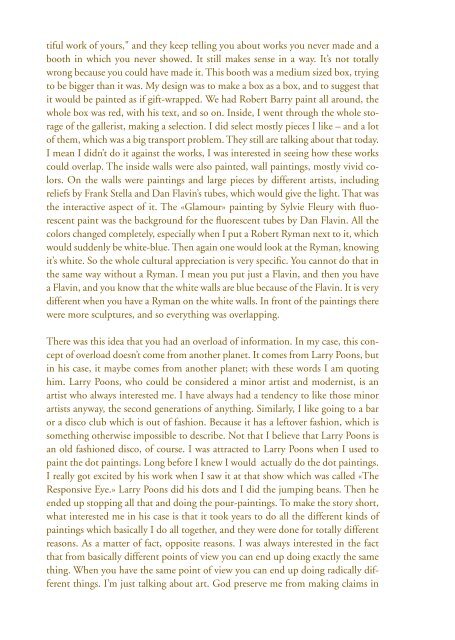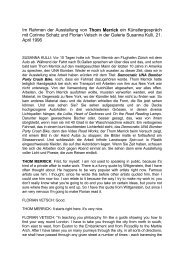Im Rahmen der Ausstellung - Galerie Susanna Kulli
Im Rahmen der Ausstellung - Galerie Susanna Kulli
Im Rahmen der Ausstellung - Galerie Susanna Kulli
You also want an ePaper? Increase the reach of your titles
YUMPU automatically turns print PDFs into web optimized ePapers that Google loves.
tiful work of yours," and they keep telling you about works you never made and a<br />
booth in which you never showed. It still makes sense in a way. It’s not totally<br />
wrong because you could have made it. This booth was a medium sized box, trying<br />
to be bigger than it was. My design was to make a box as a box, and to suggest that<br />
it would be painted as if gift-wrapped. We had Robert Barry paint all around, the<br />
whole box was red, with his text, and so on. Inside, I went through the whole storage<br />
of the gallerist, making a selection. I did select mostly pieces I like – and a lot<br />
of them, which was a big transport problem. They still are talking about that today.<br />
I mean I didn’t do it against the works, I was interested in seeing how these works<br />
could overlap. The inside walls were also painted, wall paintings, mostly vivid colors.<br />
On the walls were paintings and large pieces by different artists, inclu ding<br />
reliefs by Frank Stella and Dan Flavin’s tubes, which would give the light. That was<br />
the interactive aspect of it. The «Glamour» painting by Sylvie Fleury with fluorescent<br />
paint was the background for the fluorescent tubes by Dan Flavin. All the<br />
colors changed completely, especially when I put a Robert Ryman next to it, which<br />
would suddenly be white-blue. Then again one would look at the Ryman, knowing<br />
it’s white. So the whole cultural appreciation is very specific. You cannot do that in<br />
the same way without a Ryman. I mean you put just a Flavin, and then you have<br />
a Flavin, and you know that the white walls are blue because of the Flavin. It is very<br />
different when you have a Ryman on the white walls. In front of the paintings there<br />
were more sculptures, and so everything was overlapping.<br />
There was this idea that you had an overload of information. In my case, this concept<br />
of overload doesn’t come from another planet. It comes from Larry Poons, but<br />
in his case, it maybe comes from another planet; with these words I am quoting<br />
him. Larry Poons, who could be consi<strong>der</strong>ed a minor artist and mo<strong>der</strong>nist, is an<br />
artist who always interested me. I have always had a tendency to like those minor<br />
artists anyway, the second generations of anything. Similarly, I like going to a bar<br />
or a disco club which is out of fashion. Because it has a leftover fashion, which is<br />
something otherwise impossible to describe. Not that I believe that Larry Poons is<br />
an old fashioned disco, of course. I was attracted to Larry Poons when I used to<br />
paint the dot paintings. Long before I knew I would actually do the dot paintings.<br />
I really got excited by his work when I saw it at that show which was called «The<br />
Responsive Eye.» Larry Poons did his dots and I did the jumping beans. Then he<br />
ended up stopping all that and doing the pour-paintings. To make the story short,<br />
what interested me in his case is that it took years to do all the different kinds of<br />
paintings which basically I do all together, and they were done for totally different<br />
reasons. As a matter of fact, opposite reasons. I was always interested in the fact<br />
that from basically different points of view you can end up doing exactly the same<br />
thing. When you have the same point of view you can end up doing radically different<br />
things. I’m just talking about art. God preserve me from making claims in





